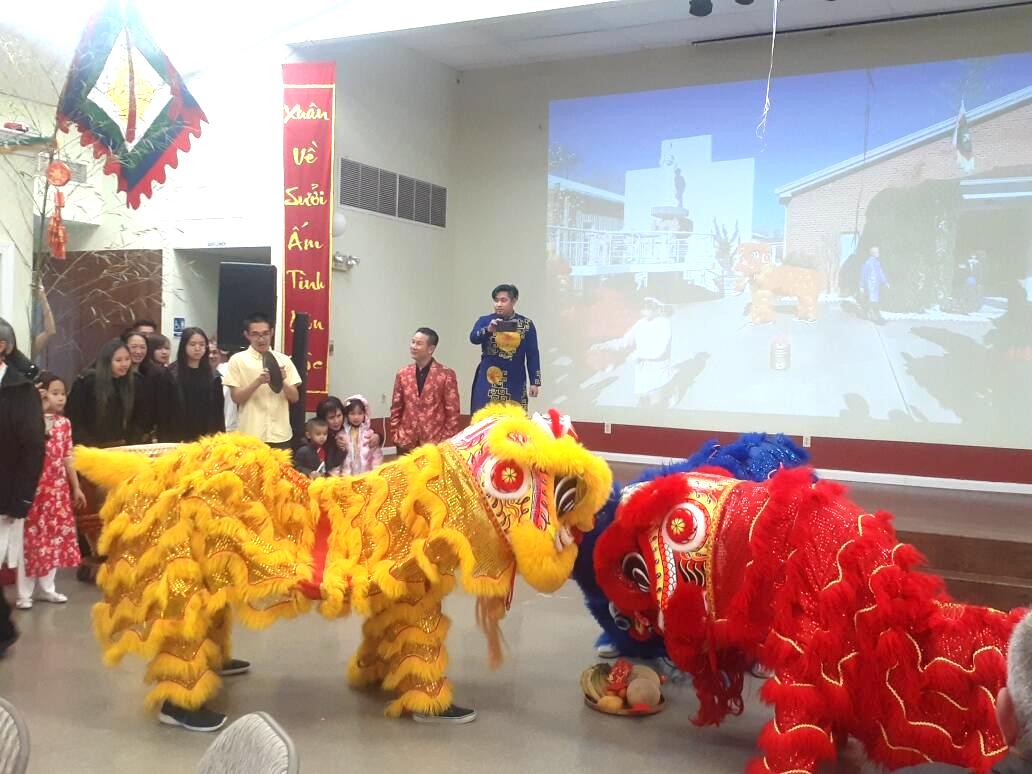Tết, the Vietnamese holiday of the Lunar New Year, is the most important and sacred time of the year in the Vietnamese culture. It was celebrated with a special Mass on Sunday, Jan. 22, at the Church of the Vietnamese Martyrs, Richmond. Father John Baptist Nguyễn, pastor, presided over the celebration, with more than 200 people attending.
“New Year’s Day brings a new beginning, getting rid of the bad things and the misfortunes of the past year, so everyone tries to be happy and generous toward each other,” said parishioner Julie Nguyễn, who is not related to Fr. Nguyễn. “It is believed that what we do on the first day of the year will affect the rest of the year. Therefore, we pay great attention to every word we say and everything we do on this day.”
Though the central celebration occurred on Jan. 22, Tết actually spans several days of preparation, gatherings, family and festivities. Nguyễn, who arrived in the United States as a child refugee in 1975, explained that it’s common to get new haircuts and clothes in an effort to begin the year anew.

People also clean their homes thoroughly before Tết, literally and figuratively sweeping away the leftover dust from the previous year to make room for good luck. Traditional food is prepared and homes are decorated with colorful arrangements of apricot blossoms, peach blossoms, chrysanthemums, orchids, and kumquat trees.
In Vietnam, people visit the graves of ancestors to pray for their souls. Families gather for feasts and dancers perform as lions and dragons in the streets. Parades march to the beat of gongs and drums while firecrackers light up the night sky.
Stateside, many try to keep these traditions alive in a myriad of ways. Before the start of Mass at the Church of the Vietnamese Martyrs, the parish elders offered in- cense in honor of the community’s ancestors, as they would in Vietnam. There was a traditional lion and dragon dance, and elders gave money to the younger churchgoers, as is common during Tết.
Center oneself on God
The altar was adorned with chrysanthemums and framed with two large banners, one stating “Họp Nhau Ấm Tình Dân Tộc (Getting Together with the Love of the Same Countrymen) and the other “Quây Quần Nhớ Tổ Việt Nam” (Gather to Commemorate Vietnamese Ancestors). Men and women wore traditional Vietnamese formal clothing, called áo dài, and “fortunes” were blessed and given to all who were present. These fortunes were rolls of paper containing Bible verses and prayers.
According to Nguyễn, Fr. Nguyễn spoke of the importance of being present in the moment during his homily, not worrying about tomorrow, but fully experiencing today. He called on his parishioners to center themselves in God. He also spoke of the significance of this particular new year, which marked the beginning of the Year of the Cat.
“The cat is gentle, steadfast, peaceful, and elegant,” said Nguyễn, who paraphrased Fr. Nguyễn’s homily. “It is one of God’s tools, and the mission for us is to be God’s tool, the tool of peace. We must develop our faith, which is our true treasure, and become a witness to our faith.”
After Mass, attendees gathered to sing karaoke, dance, eat and laugh. Parishioners also decorated and prayed at the church’s shrine to Our Lady of La Vang. La Vang is a rainforest in Vietnam where Catholics fled due to persecution around the turn of the 19th century. Many fell sick while hiding in the jungle, but they continued to pray the rosary nightly at the foot of a tree. The Virgin Mary holding the infant Jesus is said to have appeared and comforted those who were suffering from fear of death from execution or illness. The statue serves as another significant connection to their homeland.
Diverse ways to encounter Gospel
Nguyễn explained why the Church of the Vietnamese Martyrs is so important to those of Vietnamese descent in the area.
“The culture shock is very hard on them so they turn toward their faith to help them mentally and spiritually. It is better for them to practice their faith when they can understand the Word of God and the sermons thoroughly,” she said. “The cultural activities that are being practiced at the church help them transition better and live a better Christian life.”
Daniel Villar, director of the Diocese of Richmond’s Office of Ethnic Ministries, attended the Tết service. As a man with Hispanic roots, he said he was moved by the unique cultural elements he witnessed that were combined with the traditional universal Catholic Mass, which reminded him of the great diversity that can be found in the Catholic faith.
“We are all made in the image and likeness of God,” said Villar. “It is our vocation and call to encounter the Gospel through the diverse ways faith has informed culture. How beautiful it is to see the face of God through the lens of different cultures and languages!”

